Vehicular camera testing using a slanted or staggered target
Sesti , et al. May 18, 2
U.S. patent number 11,012,684 [Application Number 16/718,823] was granted by the patent office on 2021-05-18 for vehicular camera testing using a slanted or staggered target. This patent grant is currently assigned to MAGNA ELECTRONICS INC.. The grantee listed for this patent is Magna Electronics Inc.. Invention is credited to Robert A. Devota, Donald W. Mersino, Matthew C. Sesti.
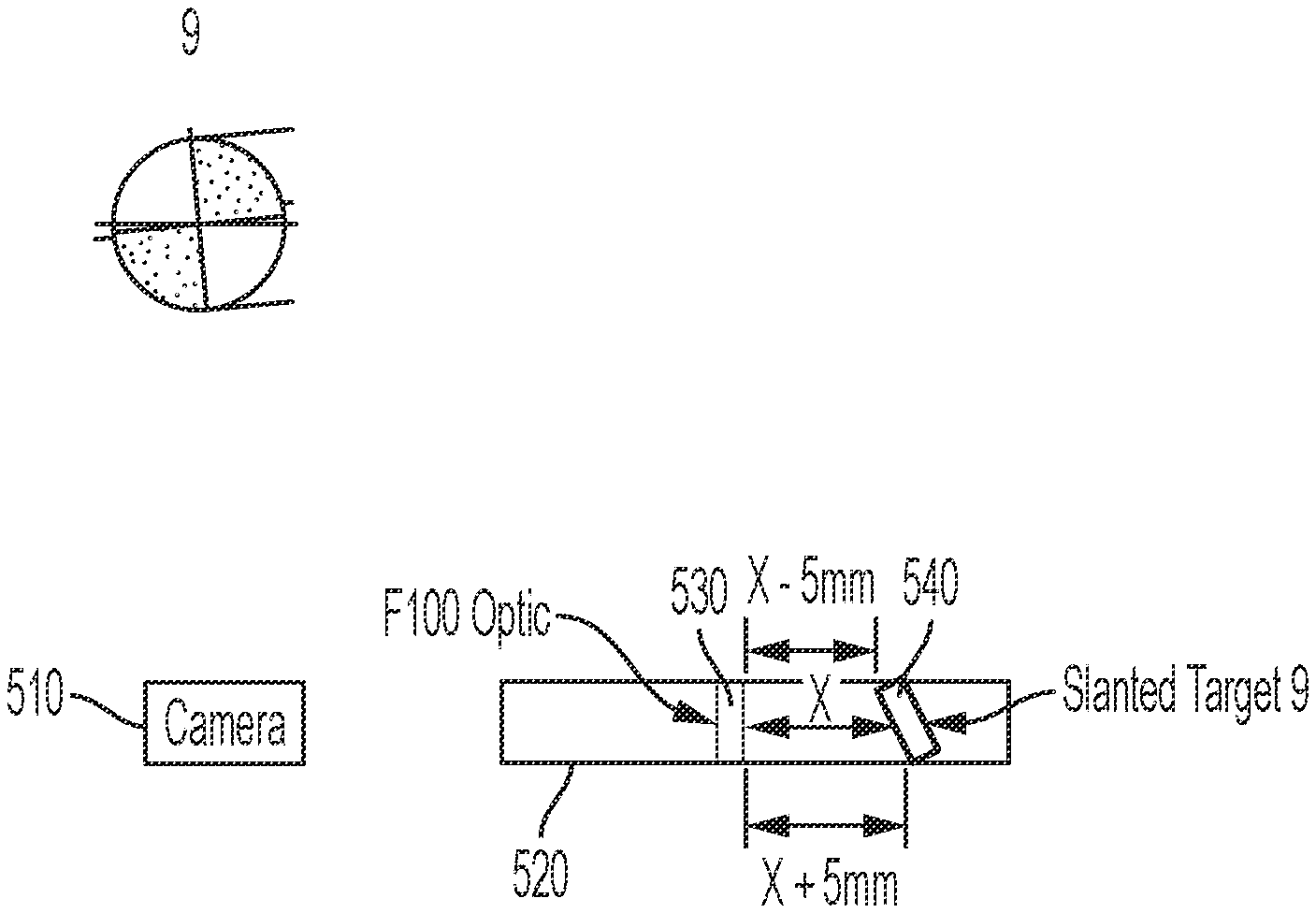
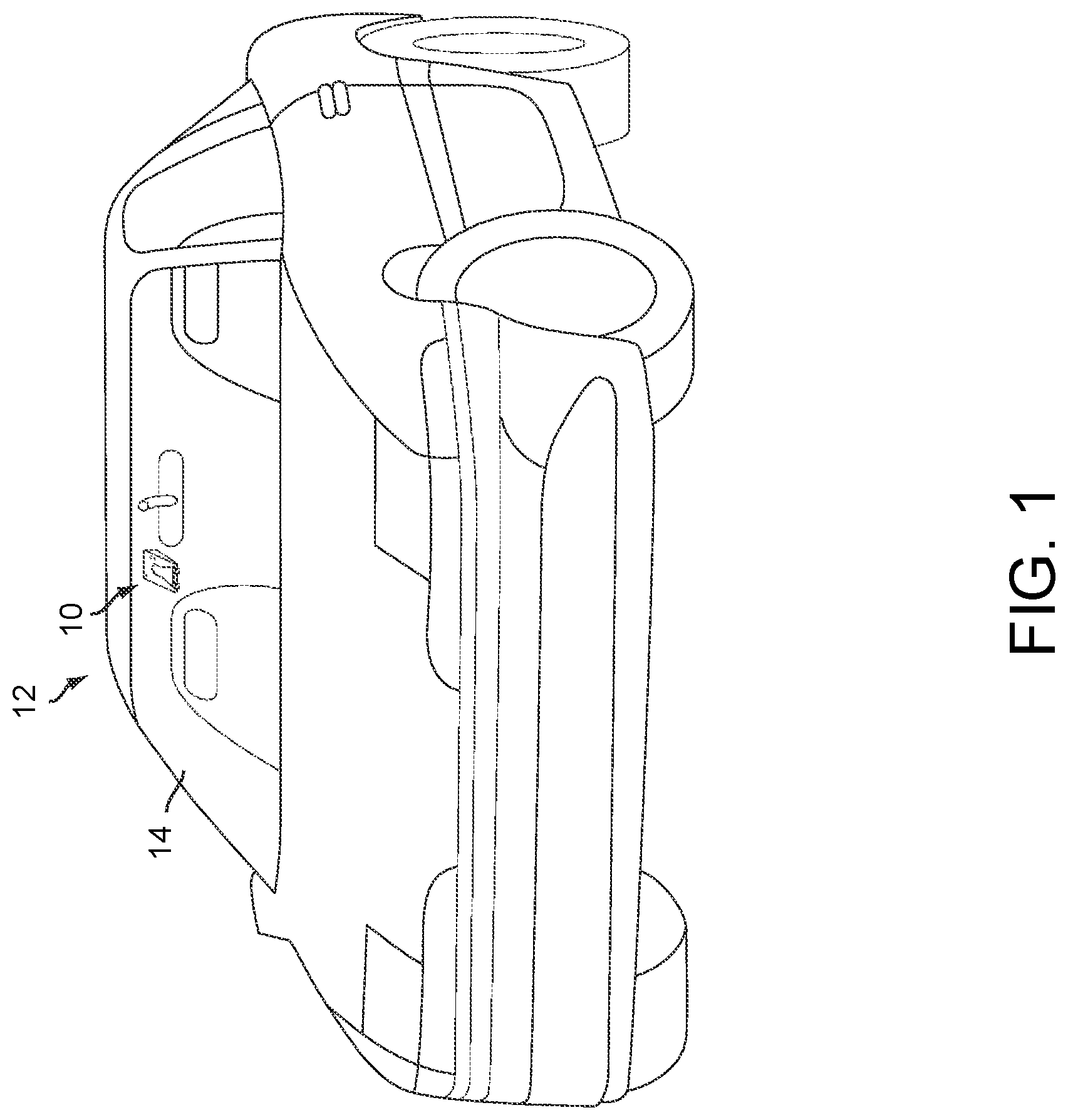
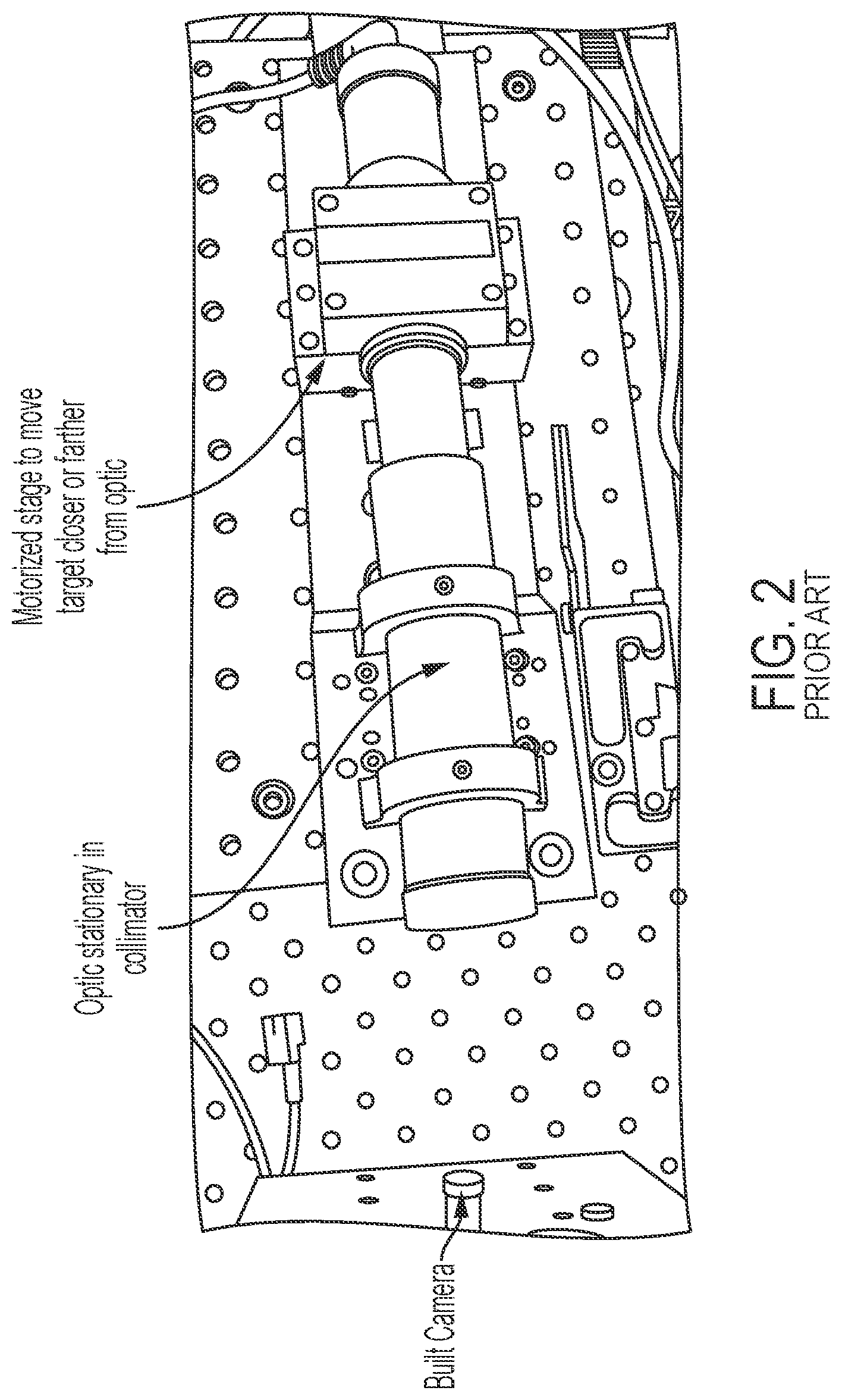
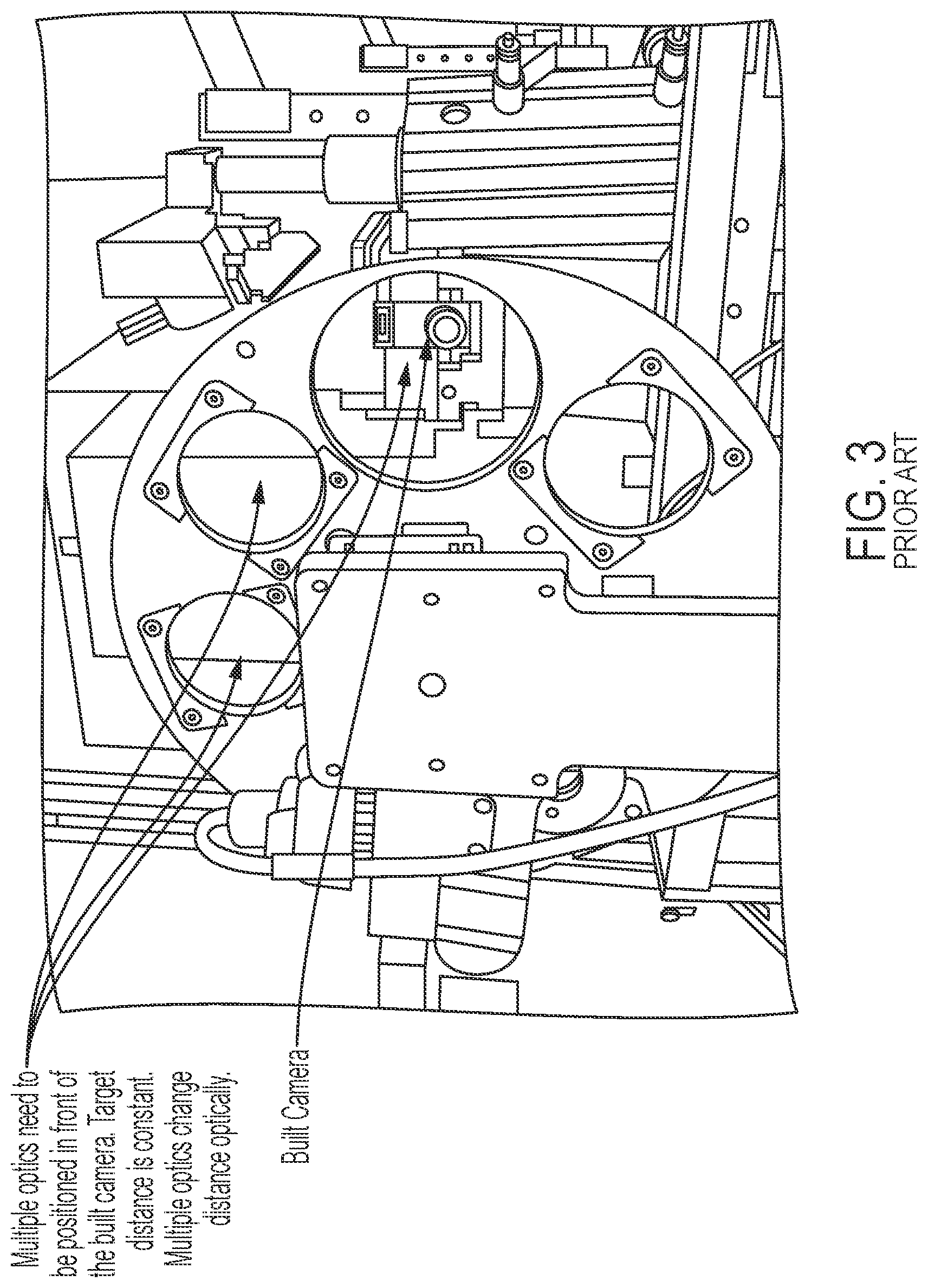
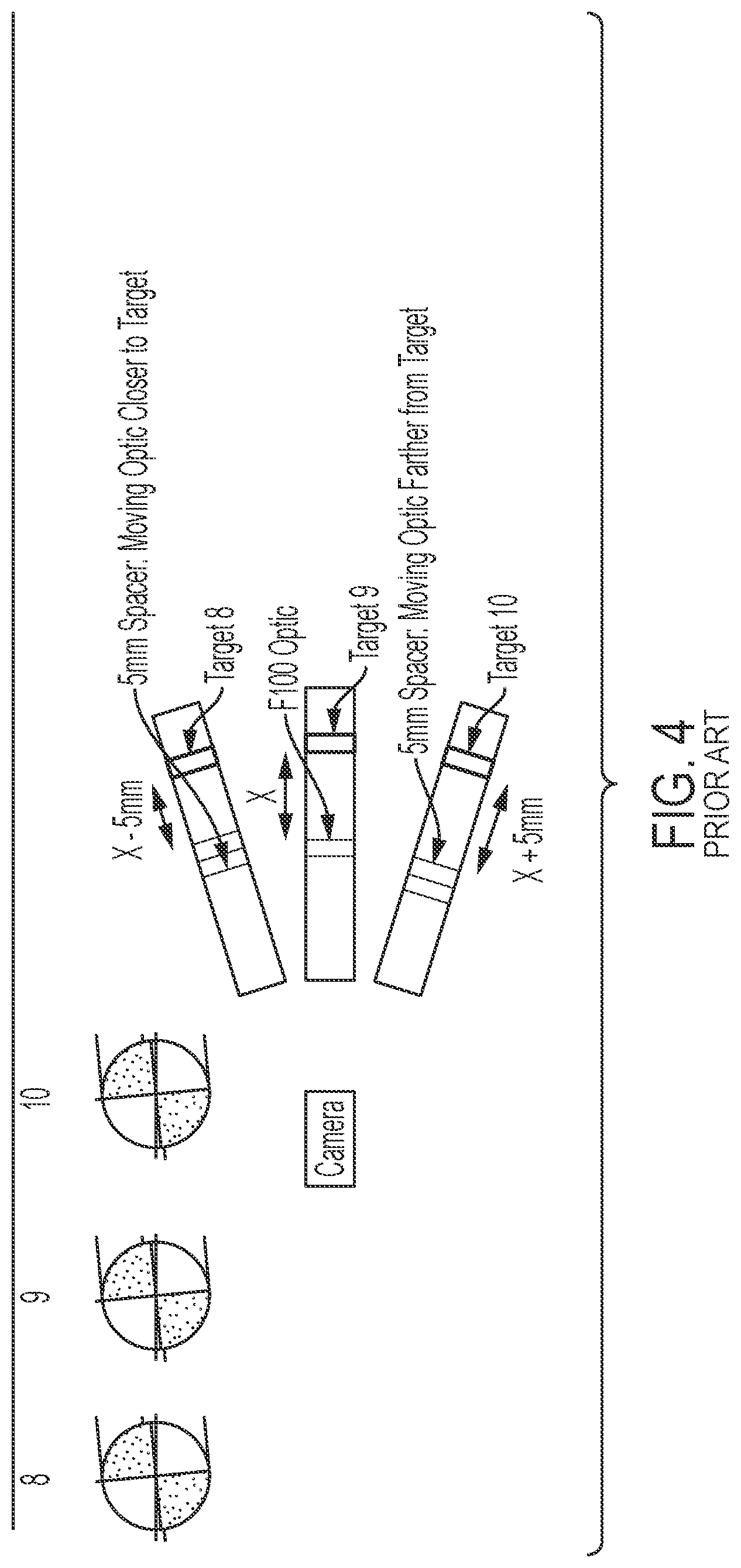
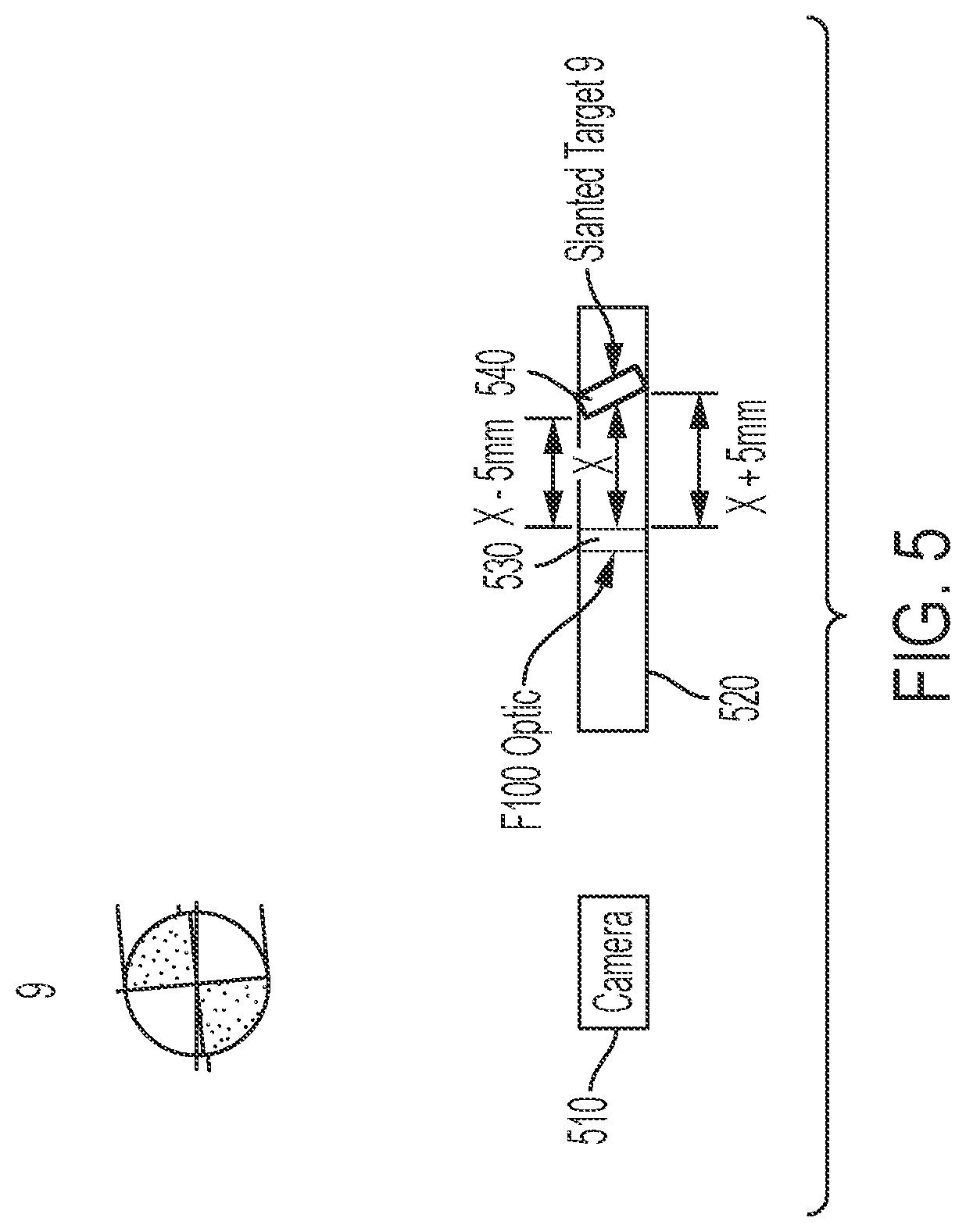
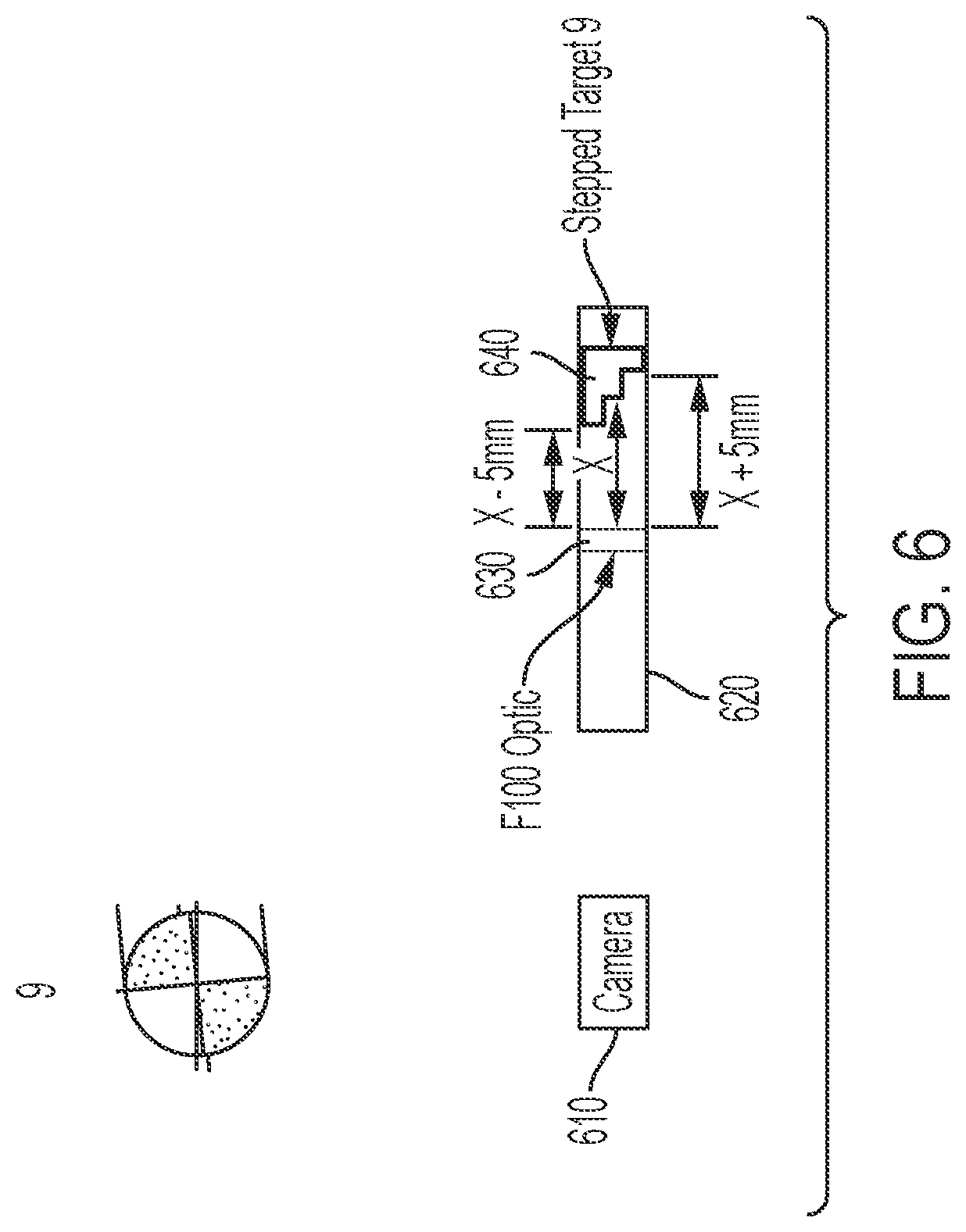
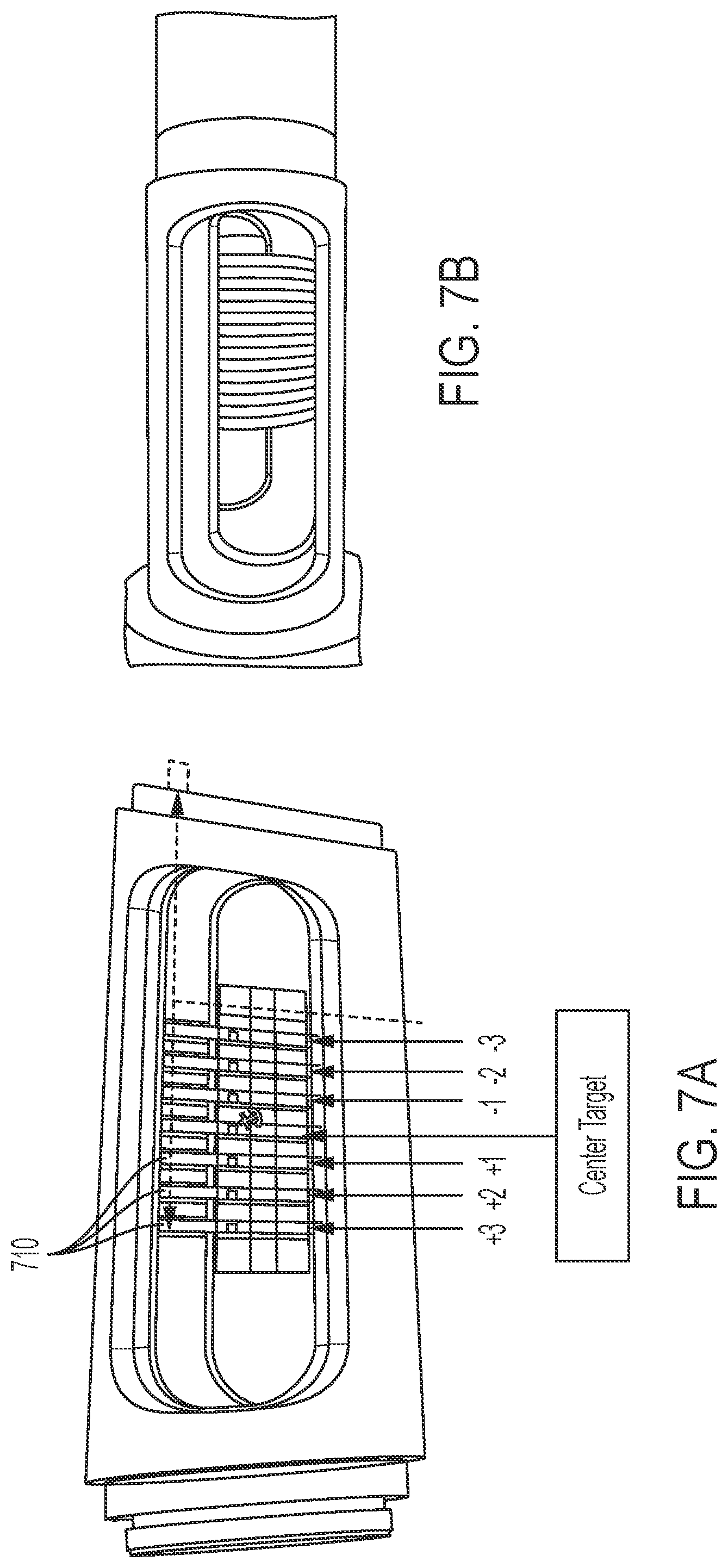
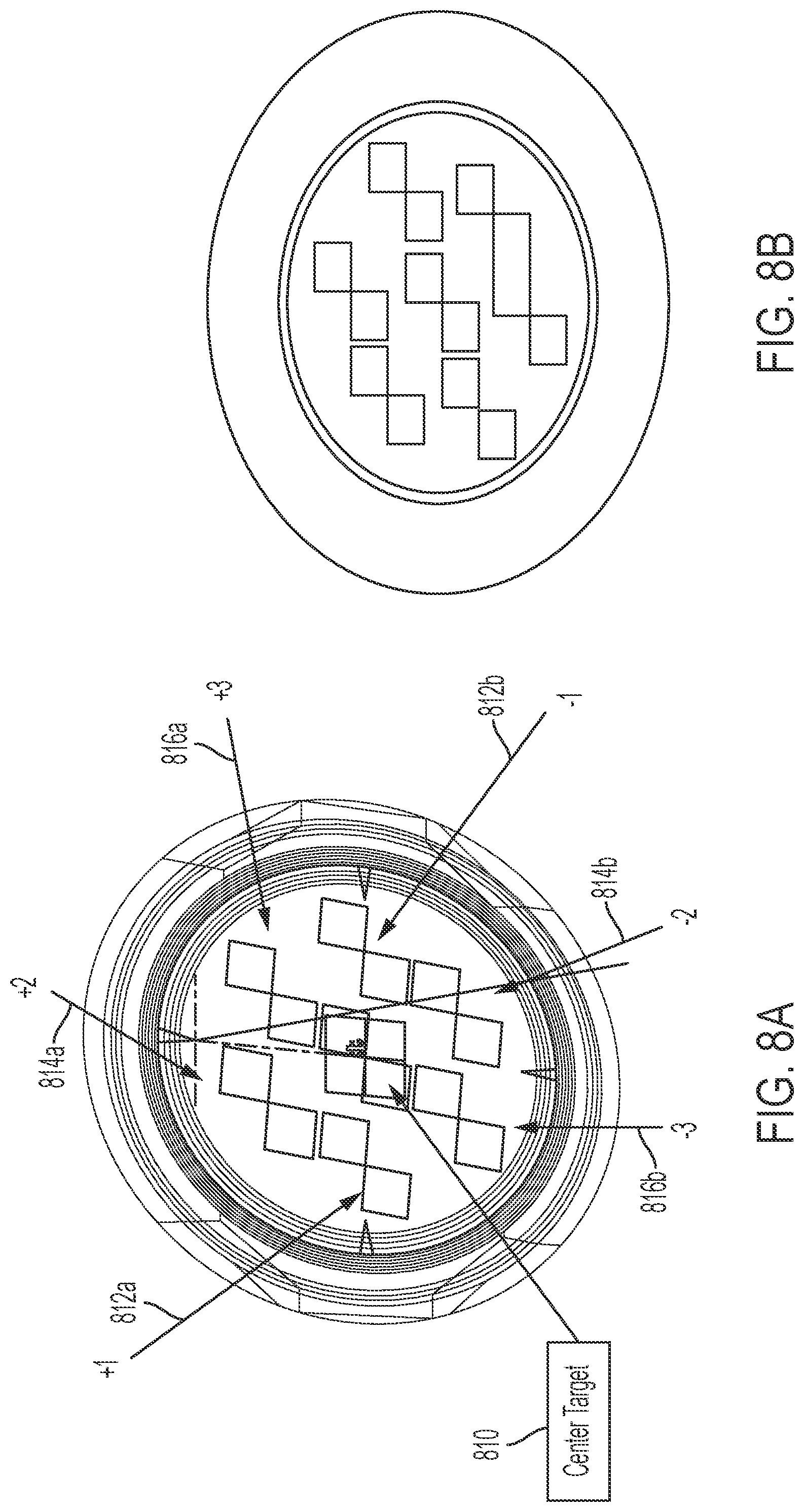
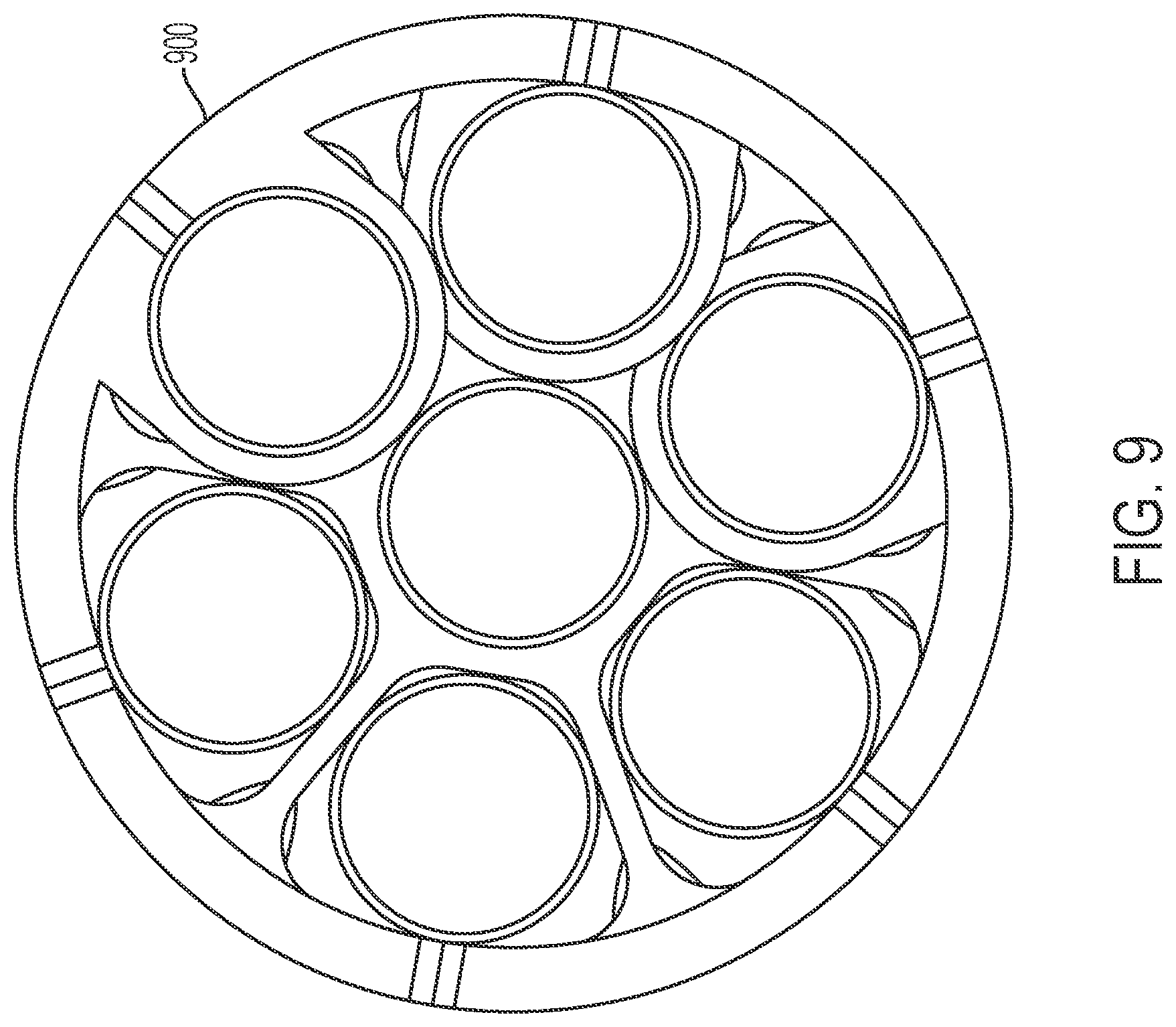
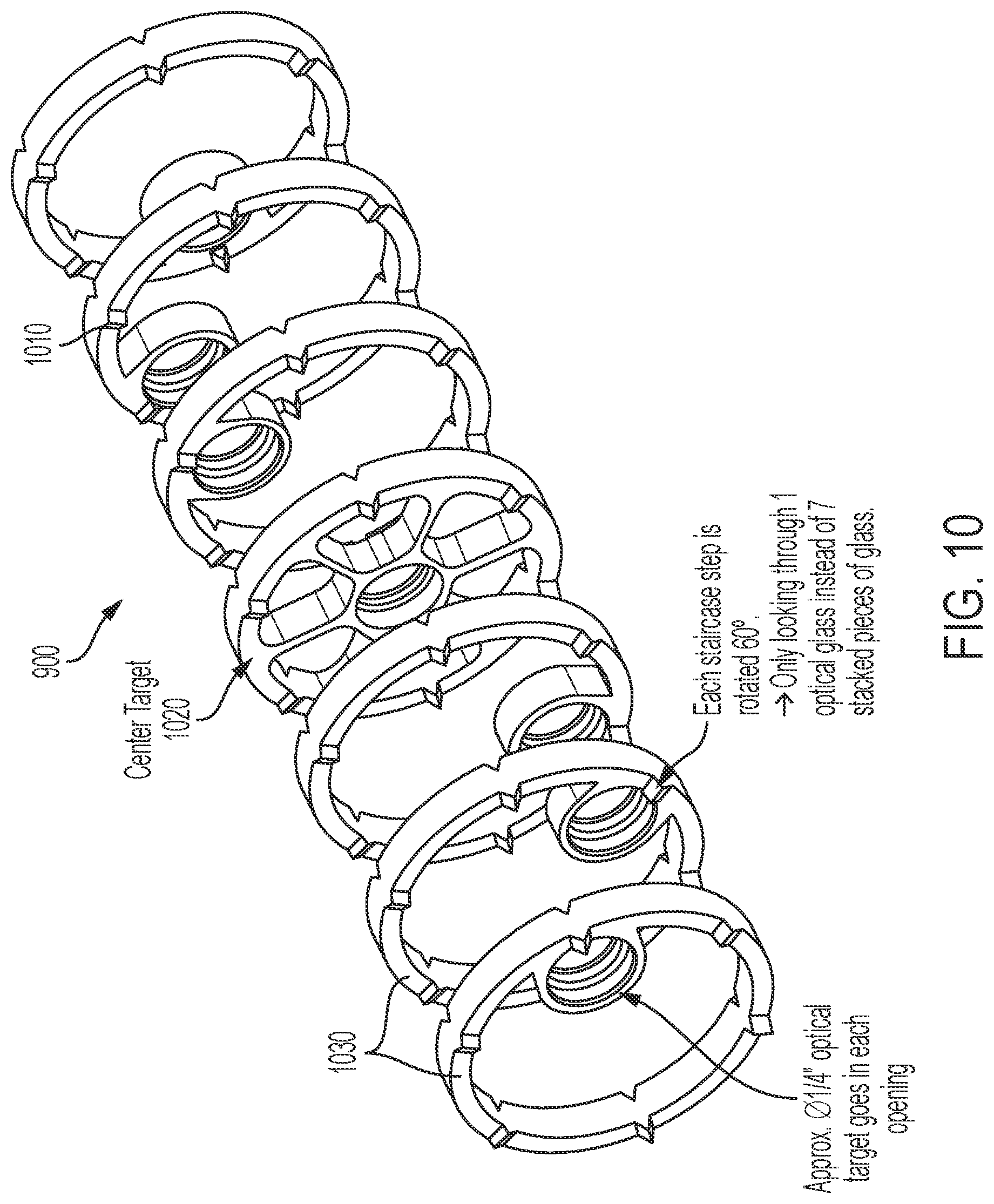
| United States Patent | 11,012,684 |
| Sesti , et al. | May 18, 2021 |
Vehicular camera testing using a slanted or staggered target
Abstract
A method of testing a vehicular camera for a vehicular vision system includes providing a vehicular camera suitable for use on a vehicle, with the vehicular camera having a field of view. A collimator is provided that includes an optic and a target. The collimator is positioned in the field of view of the vehicular camera such that the camera images light that reflects off the target and passes through the optic. The target is angled or stepped relative to an image plane of the vehicular camera. Image data is captured with the vehicular camera, with the captured image data being representative of the angled or stepped target. The captured image data is processed, via an image processor, and a defocus of the vehicular camera is estimated based on processing by the processor of the captured image data of the angled or stepped target.
| Inventors: | Sesti; Matthew C. (Williamston, MI), Mersino; Donald W. (Montrose, MI), Devota; Robert A. (Durand, MI) | ||||||||||
|---|---|---|---|---|---|---|---|---|---|---|---|
| Applicant: |
|
||||||||||
| Assignee: | MAGNA ELECTRONICS INC. (Auburn
Hills, MI) |
||||||||||
| Family ID: | 1000005562750 | ||||||||||
| Appl. No.: | 16/718,823 | ||||||||||
| Filed: | December 18, 2019 |
Prior Publication Data
| Document Identifier | Publication Date | |
|---|---|---|
| US 20200204791 A1 | Jun 25, 2020 | |
Related U.S. Patent Documents
| Application Number | Filing Date | Patent Number | Issue Date | ||
|---|---|---|---|---|---|
| 62878945 | Jul 26, 2019 | ||||
| 62781791 | Dec 19, 2018 | ||||
| Current U.S. Class: | 1/1 |
| Current CPC Class: | H04N 17/002 (20130101); H04N 5/23229 (20130101); H04N 5/2254 (20130101); B60R 11/04 (20130101); B60R 2011/0026 (20130101) |
| Current International Class: | H04N 17/00 (20060101); H04N 5/225 (20060101); B60R 11/04 (20060101); H04N 5/232 (20060101); B60R 11/00 (20060101) |
| Field of Search: | ;348/148 |
References Cited [Referenced By]
U.S. Patent Documents
| 5550677 | August 1996 | Schofield et al. |
| 5670935 | September 1997 | Schofield et al. |
| 5949331 | September 1999 | Schofield et al. |
| 7038577 | May 2006 | Pawlicki et al. |
| 7720580 | May 2010 | Higgins-Luthman |
| 7855755 | December 2010 | Weller et al. |
| 2002/0050988 | May 2002 | Petrov |
| 2005/0089208 | April 2005 | Dong et al. |
| 2006/0038910 | February 2006 | Knoedgen |
| 2006/0038976 | February 2006 | Knoedgen |
| 2007/0211240 | September 2007 | Matsumoto et al. |
| 2014/0152845 | June 2014 | Seger |
| 2015/0138372 | May 2015 | Apel |
| 2015/0277135 | October 2015 | Johnson |
| 2017/0006282 | January 2017 | Sigle |
| 2017/0132774 | May 2017 | Ruprecht |
| 2017/0234923 | August 2017 | Douglas et al. |
| 2017/0287166 | October 2017 | Claveau |
| 2018/0113321 | April 2018 | Heshmat Dehkordi |
| 2018/0302615 | October 2018 | Lehmann et al. |
| 2018/0373944 | December 2018 | Sesti et al. |
Assistant Examiner: Kim; Matthew David
Attorney, Agent or Firm: Honigman LLP
Parent Case Text
CROSS REFERENCE TO RELATED APPLICATIONS
The present application claims priority of U.S. provisional application, Ser. No. 62/878,945, filed Jul. 26, 2019, and U.S. provisional application Ser. No. 62/781,791, filed Dec. 19, 2018, which are hereby incorporated herein by reference in their entireties.
Claims
The invention claimed is:
1. A method of testing a vehicular camera for a vehicular vision system, the method comprising: providing a vehicular camera configured for use on a vehicle, wherein the vehicular camera has a field of view; providing a collimator assembly, the collimator assembly comprising an optic fixedly disposed within the collimator assembly and a target fixedly disposed within the collimator assembly; positioning the collimator assembly in the field of view of the vehicular camera such that the vehicular camera images light that has reflected off the target and that has passed through the optic and such that a longitudinal axis of the collimator assembly is aligned with a principal axis of the field of view of the vehicular camera, wherein, with the collimator assembly positioned in the field of view of the vehicular camera, the optic is perpendicular to the principal axis of the field of view of the vehicular camera and the target is angled relative to the optic and the image plane of the vehicular camera; capturing image data with the vehicular camera, wherein the captured image data is representative of the angled target; processing, via an image processor, the image data captured by the vehicular camera; and responsive to processing by the image processor of the image data captured by the vehicular camera, estimating a defocus of the vehicular camera.
2. The method of claim 1, wherein the angled target is angled at 45 degrees relative to the image plane of the vehicular camera.
3. The method of claim 1, wherein estimating the defocus of the vehicular camera comprises estimating the defocus of the vehicular camera at a plurality of positions on the angled target, each position at a different distance from the optic.
4. The method of claim 3, wherein the defocus of the vehicular camera is estimated from three positions.
5. The method of claim 1, wherein at least some of the light that has reflected off the target is emitted by a light emitting diode disposed at the collimator assembly.
6. A method of testing a vehicular camera for a vehicular vision system, the method comprising: providing a vehicular camera suitable for use on a vehicle, wherein the vehicular camera has a field of view; providing a collimator comprising an optic fixedly disposed within the collimator and a target fixedly disposed within the collimator; positioning the collimator in the field of view of the vehicular camera such that the vehicular camera images light that reflects off the target and passes through the optic and such that a longitudinal axis of the collimator is aligned with a principal axis of the field of view of the vehicular camera, wherein the optic is perpendicular to the principal axis of the field of view of the vehicular camera and the target is angled at 45 degrees relative to the optic and the image plane of the vehicular camera; capturing image data with the vehicular camera, wherein the captured image data is representative of the angled target; processing, via an image processor, image data captured by the vehicular camera; and responsive to processing by the image processor of image data captured by the vehicular camera, estimating a defocus of the vehicular camera at a plurality of positions on the angled target, each position at a different distance from the optic.
7. The method of claim 6, wherein the plurality of positions comprises three positions.
8. The method of claim 7, wherein the three positions comprises a first position, a second position, and a third position, and wherein the first position is at least five millimeters closer to the camera than the second position and wherein the second position is at least five millimeters closer to the camera than the third position.
9. The method of claim 6, wherein at least some of the light that has reflected off the target is emitted by a light emitting diode disposed at the collimator.
Description
FIELD OF THE INVENTION
The present invention relates generally to a vehicle vision system for a vehicle and, more particularly, to a vehicle vision system that utilizes one or more cameras at a vehicle.
BACKGROUND OF THE INVENTION
Use of imaging sensors in vehicle imaging systems is common and known. Examples of such known systems are described in U.S. Pat. Nos. 5,949,331; 5,670,935 and/or 5,550,677, which are hereby incorporated herein by reference in their entireties.
SUMMARY OF THE INVENTION
The present invention provides a testing system for a camera for a driver assistance system or vision system or imaging system for a vehicle. The testing system or method measures or estimates the defocus of the camera. The system includes a collimator with an internal optic and target. The target may be angled relative to an image plane of the camera or include a stepped surface within the view of the optic and camera. The defocus of the camera may be measured based on image data captured of the angled or stepped target.
These and other objects, advantages, purposes and features of the present invention will become apparent upon review of the following specification in conjunction with the drawings.
BRIEF DESCRIPTION OF THE DRAWINGS
FIG. 1 is a perspective view of a vehicle with a vision system that incorporates at least a forward camera module;
FIG. 2 is a perspective view of a motorized test system;
FIG. 3 is a perspective view of a test system with multiple optics;
FIG. 4 is a block diagram of a test system with multiple collimators;
FIG. 5 is a block diagram of a test system with a slanted target in accordance with the present invention;
FIG. 6 is a block diagram of a test system with a staggered target in accordance with the present invention;
FIGS. 7A and 7B are perspective views of a collimator with multiple targets in accordance with the present invention;
FIGS. 8A and 8B are perspective views of an etched glass target in accordance with the present invention;
FIG. 9 is a plan view of a of a staircase step collimator in accordance with the present invention; and
FIG. 10 is an exploded view of the staircase step collimator of FIG. 9.
DESCRIPTION OF THE PREFERRED EMBODIMENTS
A vehicle vision system and/or driver assist system and/or object detection system and/or alert system operates to capture images exterior of the vehicle and may process the captured image data to display images and to detect objects at or near the vehicle and in the predicted path of the vehicle, such as to assist a driver of the vehicle in maneuvering the vehicle in a rearward direction. The vision system includes an image processor or image processing system that is operable to receive image data from one or more cameras and provide an output to a display device for displaying images representative of the captured image data. Optionally, the vision system may provide display, such as a rearview display or a top down or bird's eye or surround view display or the like.
Referring now to the drawings and the illustrative embodiments depicted therein, a vision system 10 for a vehicle 12 includes at least one exterior viewing imaging sensor or camera, such as a forward viewing imaging sensor or camera, which may be disposed at and behind the windshield 14 of the vehicle and viewing forward through the windshield so as to capture image data representative of the scene occurring forward of the vehicle (FIG. 1). Optionally, the system may include multiple exterior viewing imaging sensors or cameras, such as a forward viewing camera at the front of the vehicle, and a sideward/rearward viewing camera at respective sides of the vehicle, and a rearward viewing camera at the rear of the vehicle, which capture images exterior of the vehicle. The camera or cameras each include a lens for focusing images at or onto an imaging array or imaging plane or imager of the camera. Optionally, the forward viewing camera may be disposed at the windshield of the vehicle and view through the windshield and forward of the vehicle, such as for a machine vision system (such as for traffic sign recognition, headlamp control, pedestrian detection, collision avoidance, lane marker detection and/or the like). The vision system 10 includes a control or electronic control unit (ECU) or processor that is operable to process image data captured by the camera or cameras and may detect objects or the like and/or provide displayed images at a display device for viewing by the driver of the vehicle. The data transfer or signal communication from the camera to the ECU may comprise any suitable data or communication link, such as a vehicle network bus or the like of the equipped vehicle.
The system or method of the present invention estimates or measures the defocus of a vehicular camera. Typically, the ability to determine a position of a lens (i.e., an optic) in relation to an imager is accomplished by one of three methods. First, as illustrated in FIG. 2, the defocus may be estimated by utilizing a motorized stage to move a target to different distances in relation to the optic. This method increases cycle time, requires a complex motorized system, incurs significant equipment costs, and requires moving parts to estimate defocus. Second, as illustrated in FIG. 3, the defocus may be estimated by using multiple collimators with targets located in different positions in relation to the optic. This method also increases cycle time due to measuring with multiple optics, requires a complex motorized system, incurs significant equipment costs, and requires moving parts to estimate defocus. Third, as illustrated in FIG. 4, the defocus may be estimated by using different optics to simulate different distances. This method increases costs due to the multiple collimators, increases the complexity of the collimators, and potentially decreases accuracy (due to measuring different collimators in different locations). These processes are commonly referred to as measuring or estimating the defocus of a camera. That is, these processes determine how far off peak the finished camera is.
The system or method of the present invention (FIGS. 5 and 6) uses a single collimator and positions an internal target at different distances relative to the optic. Thus, only a single collimator without moving parts is used. This allows for reduced capital expenditures, reduced collimator complexity, and increases accuracy due to measuring with only a single collimator at a single location. Additionally, the present invention provides the ability to measure defocus in each collimator location and does not require moving parts to estimate or measure defocus. Image data captured by the camera with the target or targets present in the field of view of the camera is processed (via an image processor) to determine or estimate the degree of focus or defocus of the camera at the target.
Referring now to FIG. 5, a camera 510 has a field of view that includes a collimator 520. The collimator 520 includes a lens or optic 530 and target 540. The target 540 is angled relative to an image plane of the camera 510. For example, the target 540 may be angled at 45 degrees relative to the image plane of the camera 510. The angling of the target 540 results in one edge of the target 540 being closer to the optic 530 (and camera 510) than the opposite edge. For example, if the distance between the optic 530 and the center of the target 540 is x, one edge may be x-5 mm while the opposite edge is x+5 mm. Thus, the camera 510 may image the target 540 at a plurality of distances without moving the camera 510, the collimator 520, the optic 530, or the target 540.
In another implementation, a camera 610 has a field of view that includes a collimator 620 (FIG. 6). The collimator 620 includes a lens or optic 630 and target 640. The target 640 includes a stepped surface that is within the field of view of the camera 610. The target 640 may include a plurality of steps, each step a different distance from the optic 630 and camera 610. For example, the target 640 may include 3 steps. In that example, if the distance between the optic 630 and the center step is x, one step may be x-5 mm while the third step is x+5 mm. The target 640 may include any number of steps. The steps may maintain a regular distance from one step to the next or an irregular distance. Thus, the camera 610 may image the target 640 at a plurality of distances without moving the camera 610, the collimator 620, the optic 630, or the target 640.
In some examples, the system includes multiple targets 710 to increase the measurement window. That is, additional targets may be added before and/or after a center target (FIGS. 7A and 7B). For example, the system may include a total of seven targets 710, and the center target may have one, two, or three targets in front of it (i.e., +1, +2, and +3) and one, two, or three targets behind it (i.e., -1, -2, and -3).
Optionally, and with reference to FIG. 8A, the system may include glass targets with patterns laser etched onto the glass to improve black-to-white transition, with each stacked as illustrated in FIGS. 7A and 7B. The glass targets may have any diameter. For example, the targets may have a one inch diameter. Each target may have a different pattern thus giving the collimator multiple patterns at different distances. In some examples, four different patterns are used: a center target pattern and three other target patterns equally spaced around the center target pattern (FIG. 8A). For example, the center target 810 may have a unique pattern, the +1 and -1 targets 812a, 812b may share a pattern, the +2 and -2 targets 814a, 814b may share a pattern, and the +3 and -3 targets 816a, 816b may share a pattern for a total of four separate patterns. The patterns may include interlocking squares or rectangles that create high contrast (FIG. 8B).
Referring now to FIG. 9, in another example, the target may include a staircase collimator 900 with multiple (e.g., seven) targets. That is, the target may include multiple staircase "steps" 900, each with a single target disposed within an opening 1010 of the step (FIG. 10). The target disposed within each opening of each step may include optical glass (e.g., a quarter inch in diameter optical target). One step may be a center target step 1020 while the remaining steps are non-center steps 1030. The center step 1020 may include the opening 1010 in the center of the step. Each non-center step 1030 may include the opening 1010 for the target around the perimeter of the step, and each step may be rotated with respect to the other non-center steps so that the camera views each target through a single piece of glass (as opposed to multiple pieces of glass for multiple targets). For example, there may be seven steps 900 (and therefore seven targets). For example, six of the non-center steps 1030 may be each offset 60 degrees from the previous to create a ring of targets and the seventh may be disposed in the center of the step (i.e., in the center of the ring of six targets).
Thus, the system of the present invention includes a single collimator without moving parts and with one or more targets that measures the defocus of a camera. The collimator may include a light emitting diode (LED) light source. High precision tooling (e.g., Fullcut Mill (FCM) 3) may be used to improve stability. Image data captured by the camera with the target or targets present in the field of view of the camera is processed (via an image processor) to determine the degree of focus or defocus of the camera at the target.
The system includes an image processor operable to process image data captured by the camera or cameras. For example, the image processor may comprise an image processing chip selected from the EYEQ family of image processing chips available from Mobileye Vision Technologies Ltd. of Jerusalem, Israel, and may include object detection software (such as the types described in U.S. Pat. Nos. 7,855,755; 7,720,580 and/or 7,038,577, which are hereby incorporated herein by reference in their entireties), and may analyze image data to detect vehicles and/or other objects. The system may utilize aspects of the systems described in U.S. Publication No. US-2018-0373944, which is hereby incorporated herein by reference in its entirety.
For example, the vision system and/or processing and/or camera and/or circuitry may utilize aspects described in U.S. Pat. Nos. 9,233,641; 9,146,898; 9,174,574; 9,090,234; 9,077,098; 8,818,042; 8,886,401; 9,077,962; 9,068,390; 9,140,789; 9,092,986; 9,205,776; 8,917,169; 8,694,224; 7,005,974; 5,760,962; 5,877,897; 5,796,094; 5,949,331; 6,222,447; 6,302,545; 6,396,397; 6,498,620; 6,523,964; 6,611,202; 6,201,642; 6,690,268; 6,717,610; 6,757,109; 6,802,617; 6,806,452; 6,822,563; 6,891,563; 6,946,978; 7,859,565; 5,550,677; 5,670,935; 6,636,258; 7,145,519; 7,161,616; 7,230,640; 7,248,283; 7,295,229; 7,301,466; 7,592,928; 7,881,496; 7,720,580; 7,038,577; 6,882,287; 5,929,786 and/or 5,786,772, and/or U.S. Publication Nos. US-2014-0340510; US-2014-0313339; US-2014-0347486; US-2014-0320658; US-2014-0336876; US-2014-0307095; US-2014-0327774; US-2014-0327772; US-2014-0320636; US-2014-0293057; US-2014-0309884; US-2014-0226012; US-2014-0293042; US-2014-0218535; US-2014-0218535; US-2014-0247354; US-2014-0247355; US-2014-0247352; US-2014-0232869; US-2014-0211009; US-2014-0160276; US-2014-0168437; US-2014-0168415; US-2014-0160291; US-2014-0152825; US-2014-0139676; US-2014-0138140; US-2014-0104426; US-2014-0098229; US-2014-0085472; US-2014-0067206; US-2014-0049646; US-2014-0052340; US-2014-0025240; US-2014-0028852; US-2014-005907; US-2013-0314503; US-2013-0298866; US-2013-0222593; US-2013-0300869; US-2013-0278769; US-2013-0258077; US-2013-0258077; US-2013-0242099; US-2013-0215271; US-2013-0141578 and/or US-2013-0002873, which are all hereby incorporated herein by reference in their entireties. The system may communicate with other communication systems via any suitable means, such as by utilizing aspects of the systems described in International Publication Nos. WO 2010/144900; WO 2013/043661 and/or WO 2013/081985, and/or U.S. Pat. No. 9,126,525, which are hereby incorporated herein by reference in their entireties.
Changes and modifications in the specifically described embodiments can be carried out without departing from the principles of the invention, which is intended to be limited only by the scope of the appended claims, as interpreted according to the principles of patent law including the doctrine of equivalents.
* * * * *
D00000

D00001

D00002

D00003

D00004

D00005

D00006

D00007

D00008

D00009

D00010

XML
uspto.report is an independent third-party trademark research tool that is not affiliated, endorsed, or sponsored by the United States Patent and Trademark Office (USPTO) or any other governmental organization. The information provided by uspto.report is based on publicly available data at the time of writing and is intended for informational purposes only.
While we strive to provide accurate and up-to-date information, we do not guarantee the accuracy, completeness, reliability, or suitability of the information displayed on this site. The use of this site is at your own risk. Any reliance you place on such information is therefore strictly at your own risk.
All official trademark data, including owner information, should be verified by visiting the official USPTO website at www.uspto.gov. This site is not intended to replace professional legal advice and should not be used as a substitute for consulting with a legal professional who is knowledgeable about trademark law.